#encounter design
Explore tagged Tumblr posts
Text
1d12 ways to complicate an encounter
A magic or mundane artifact generates an effect harmful to the PCs, but it is guarded by the monster's minions.
The encounter's setting starts to collapse during the battle, and all the combatants will need to escape.
A boss monster has a 'second form' that activates mid-way through the battle.
Traps are placed throughout the battlefield, and characters must be wary of them.
The PCs must complete a ritual while fending off attacks from the enemy.
The encounter area is a series of cliffs or platforms, forcing characters to jump around and risk falling, possibly into a pit, water, or lava.
There is a monster that uses the blink spell or tunneling to avoid attacks between its turns.
A minor enemy has the ability to summon or call for reinforcements every round.
There are three sides, not two, battling in this encounter.
A disastrous environmental effect, such as an avalanche, wildfire, or earthquake, occurs in the area, dealing damage and forcing the combatants apart.
An anti-magic pulse affects some areas of the battlefield periodically, suppressing spells and magical items when it is active.
The enemies are shockingly weak and easily defeated, but the PCs' goal isn't here -- the treasure chest is a mimic, or their princess is in another castle.
696 notes
·
View notes
Text
People are quick to point out that Dungeons and Dragons is designed for dungeon crawler adventures and a lot of the problems players experience come from trying to use the system for things it wasn't designed for. We've all read a hundred think pieces about how it's bad actually that DnD has rules that most players ignore and how there's a lot of unnecessary complexity. Everyone knows that the game is awkwardly trapped between a style of fantasy steeped in mid 20th Century ideas about race and a desire to make the game as inclusive as possible.
But for some reason, I'm the only person here willing to point out the biggest and most obvious flaw with Dungeons and Dragons! Everyone else is too scared to say it, so I guess I will have to be the one to point it out!
The cramped dungeon environment is a really bad fit for dragons. The ability to take to the wing is an important aspect of dragons, both strategically as a game element and mythologically as a representation of unconstrained power. If you put a dragon inside of a dungeon, you are severely limiting the dragons ability to control the pace and shape of the battle. The ability to make tactical fly-by strikes and disrupt their enemies, both with blasts of fire breath and by snatching specific targets and moving them away from their defensive positions, are incredibly important for making dragons complex, engaging, and terrifying foes.
Fighting a dragon inside the dungeon does make sense for a group of level 1 noobs fighting their first white dragon hatchling. You don't want those players feeling overwhelmed, so limiting what the dragon can do makes for a better encounter. However, once your players are familiar with the game, take that adult red dragon and put it outside! The dragon will be able to take full advantage of its more unique abilities and your players will feel challenged to come up with clever solutions to limit the dragon's abilities and turn the tides of battle in their favor. Having to constrain and ground the dragon and then fighting the beast head-on creates a satisfying flow to combat, where the players' actions can significantly impact the battle beyond just reducing the enemy's hit points.
12 notes
·
View notes
Text
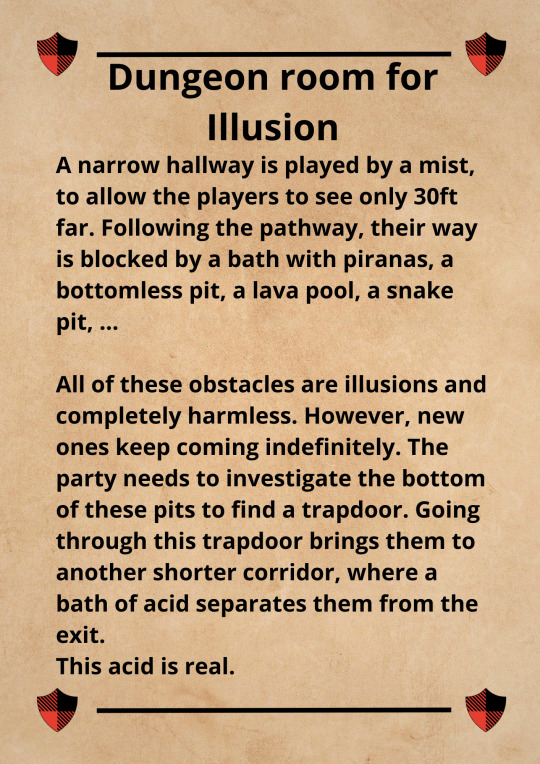
If your party keeps on going forward you'll have to improvise more fake traps.
#dnd#dungeons and dragons#dnd5e#5e#fantasy#homebrew#fiction#side quests#level design#random encounters#encounter design#ttrpg#tabletop
8 notes
·
View notes
Text
Involved TTRPG Combat
I just wanted to give my own two cents on "involved" combat encounters in D&D and similar TTRPGs.
Generally give your players the expectations that combats are something to be solved rather than beaten. Communicate that with them clearly in order to create more fulfilling combat that isn't hitting things until no enemies are still alive.
Give combat encounters a goal. I'll list a few examples later, but generally you should think of what an encounter is meant to achieve for the players. Sometimes it's fine if it's just "an obstacle meant to be overcome", but this shouldn't be the only goal.
Consider tipping points, when it becomes clear that victory is certain for the player characters, but the combat could still continue. Create off-ramps for such encounters, where you can have a satisfying narrative way of ending it earlier. Fleeing minions after the leader has been killed is a classic.
Consider the environment. Cover, different types of elevation, and dynamic elements (vehicles, rotating gears, a rushing stream, etc) will make an encounter more engaging. This is more challenging to run theater-of-the-mind than with minitiatures/VTTs, but still doable.
Use different types of enemies in the same encounter. A simple way is to use both ranged and melee attackers, allowing your players with ranged options to pick off the enemies further away, while the melee-based heroes have their own enemies to deal with.
Have enemies with multiple phases. In 5e, enemies with the Mythic trait (mostly found in Mythic Odysseys of Theros and Fizban's Treasury of Dragons) are one example for this, as they gain more abilities the more damage they take. Alternatively consider creating monsters that consist of multiple stat blocks, where defeating certain parts of it changes what it can do and what your players can do to it. E.g. turn Mazaal from The Legend of Zelda - The Minish Cap, into a D&D monster.
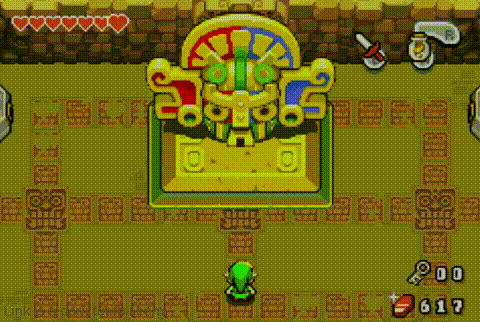
I'm not good at making monster stat blocks, but imagine a construct with two hands (each with a distinct stat block) and a head that shoots beams from its eyes. The head has a Tethered trait that makes it invulnerable while the hands (that can grapple your heroes!) are still active. Once the hands are defeated the head starts jumping around like crazy, knocking over the heroes with shockwaves as it hits the ground. That sounds like a very engaging combat encounter to me!
Now when it comes to combat goals, here are a few suggestions:
Ensuring the safety of an escorted NPC or a valuable item that the party is transporting to a different loccation.
Keeping an enemy in a magic circle that allows it to be killed permanently, since it would otherwise just regenerate or be outright invulnerable.
Waiting for reinforcements as hordes of enemies attack the party, placing a timer on the encounter.
Preventing an enemy from reaching a specific spot on the map, such as an altar or a mechanism.
68 notes
·
View notes
Text
Letting Players Feel Smart in Combat
or, "Running Encounters with an Information Economy"
PREAMBLE: Something that frustrated me for a long time as a player in TTRPGs was how hard it could be to guess enemy tactics. There are a lot of things that you can do with good tactics, but a lot of the time you lack the information to use those tactics. For example, setting up a prepared action to counterspell just wastes your turn if nobody tries to cast anything. This can be especially frustrating when you're up first in the initiative, and don't have much more than just a description of who/what you're fighting to go off of.
AN ANECDOTE: One day I decided to try an experiment. Each round of combat was supposed to be happening in the same six seconds of elapsed time, right? So, the next time I went first, I asked my GM if I could see what the enemies were doing - everything was happening at the same time, so I should be able to read their body language, the directions they were starting to move, and where they were looking to get an idea of how they were going to act, right?
As I honestly had been expecting, my GM said no. It wasn't their turn yet, so they weren't doing anything yet. I resolved that I did not want to run my own games that way, so I came up with some ways that when I ran a game, I could help my players to not be going into battle completely blind.
THE POINT: Tipping players off to enemy tactics is just good GMing. When they get a "read" on an enemy, they'll feel like an absolute genius. When the party plans for what the enemy will do and uses tactics to put the odds in their favor, they will lose their minds over how cool they feel. Here's a couple things I do to make that happen.
The first is giving enemies tells for what they're planning, which sounds simple, but actually requires a change to how encounters are typically run. Basically, you should know what an enemy will do before their turn, and typically at the end of the last one. Then you narrate them doing something to hint at that as part of their action. For example, a dragon might inhale deeply before using its breath weapon, or a manticore might slowly go from lashing its tail from side to side to holding it stiff as it prepares to launch a volley of spikes.
You don't have to stay committed to a course of action once you've given a tell, but if the players do something that would cause an enemy to reconsider its tactics (or determine them, if you hadn't decided anything for it yet), that's another time to give a tell. For instance, you might have already described a dire wolf lowering on its haunches as it starts stalking toward the ranger, ready to pounce, when the halfling rogue stops taking cover behind the fighter. In that case, you might describe the dire wolf shifting its stance, licking its lips as it turns its attention to this weaker-looking prey.
There's no need to give a tell for every action, of course. That would get taxing for you, and tedious for the party. Generously sprinkling in clues as to key things enemies want to do can keep players engaged, and help them break through the indecision about what to do with their own turns, though.
That brings me to my other trick. If you read the anecdote section above, this is something I came up with as a direct result of that. I decided to add a special action type that is just for the players, the "Observe Action". Every player gets one Observe Action on each of their turns that they can use in a number of ways to get more information about the conditions on the battlefield, or to gain an advantage.
The first use is just applying their skills in the normal way. If they could use a skill to recall information about a particular creature, they now do this as an Observe Action. This one is technically an explicit nerf in Pathfinder, since recalling is stated to be no action, but I find that most groups only check on one monster at a time anyway, and on the occasions when they don't, starting combat with check spam just slows the action down, so I include it. It usually doesn't hurt anything, and having it on the list can actually remind players that doing this is a thing they can do in the first place.
The second is also more or less a bookkeeping task, and that's using informational magic, like the Detect spells. It doesn't change the cast time, but once the spell is up, any further focus to gain more information uses their Observe Action. This is mostly just to remind players they can have these going while they fight, but I do also make any part of using the spell once cast that would normally be a Standard Action into an Observe instead, as a small bonus.
The third use, and the first truly new option, is to "read" a group. This is similar to recalling information, but allows for some different questions to be asked. Use these as a baseline.
Who has the highest/lowest HP?
Who can deal the most damage with physical attacks.
Who has the highest bonus to hit?
General "lean" of the group's alignment. (Most common alignment component on a single axis.)
How challenging does this fight look? (General CR range of the encounter, described as Easy, Average, Challenging, etc...)
Individual with the highest/lowest value in a particular ability score.
Highest/lowest value in a particular saving throw.
Basically, this option is there to help players decide who to focus their attention on. Let them use it for whatever will help them get a better idea of who or what they're facing. Let them ask their main question up-front before rolling to establish the check (whatever skill and DC seems appropriate), but let them ask additional questions after if they get a high roll.
It goes hand in hand with the last option, which is gauging intent. This one should probably be done with Insight/Sense Motive, and it just comes down to that original question. What's going to happen next?
The first way this can work is that the player focuses on a specific enemy, and gets a sense of what that enemy specifically intends to do. In other words, the player tells you who they want to get a "tell" for, and if they succeed, you give it to them.
Alternatively, the player might ask if anyone in the enemy group is about to take a specific action. For example, "Is the cleric about to get targeted." or "Does anyone look like they're going to call for backup?" So basically, instead of focusing on the behavior of one individual, the player is staying alert for a particular situation. Don't let the players get too broad with this one, of course, but it's okay to be a little generous with what they can ask about.
Even more than when I advised it above, if someone successfully gauges the intent of their enemy, and that intent changes, let them know. You should treat a success as them continuing to be alert to what they were observing for until their next turn.
I also toyed with the idea of letting players use their Observation to look for openings to improve their chance of hitting, or for a weak spot to do more damage. I like the idea of this, but felt like it stepped on the toes of other, existing options too much, and would be too tempting to players over the other uses. So I decided to keep Observation Actions as purely a source of information, and not directly pumping numbers. Still, if it sounds like it would work for you, try it out.
For everyone who read this incredibly long post of mine, I hope it helps you out. I haven't done a post like this in a long time, and I really appreciate you taking the time to read it. If these rules improve anyone else's games, hearing that would really make my day.
#ttrpg#tabletop roleplaying#dungeons & dragons#pathfinder#game mastery#running the game#encounter design#roleplaying games#game master advice#house rules#long post#essay#homebrew#this is just what works for me
88 notes
·
View notes
Text
Help me design an encounter
I am terrible in mathing out 5e encounters, and this one is actually important
I want an encounter with Orc bandits, who use goblin slaves as cannon fodder. They are trying to steal food from a merchant passing along a road. The players spot it from far away, and can ambush the bandits. The encounter happens in the woods.
The goal of the encounter should be to defeat\kill the bandits, but protecting the merchant, or at the very least his food
I want the map to have elements of the third dimension, and I want it to be blanced to be an easy encounter to kill everyone, but that protecting the merchant will be difficult
The group is 7 players with 5th-level characters, half casters half not.
Any help?
6 notes
·
View notes
Text
One thing I really appreciate about Baldur's Gate 3 is that, despite being based on D&D 5e (a game which I often criticise as being "too easy" or "impossible for PCs to die in"), you actually will get your shit rocked if you go into encounters without all your resources or with weak builds or rubbish tactics. If you get surprised and can't act on the first round, you're probably gonna face a death or two! Or a TPK!
I was shocked recently when I started a new playthrough (on Balanced mode, I might add) with no party members who could cast Healing Word. I thought that it wouldn't matter, but I was horribly mistaken.
It's strange because when I'm playing the tabletop game I nearly never take Healing Word. Why would I when it only heals 1d4 and Cure Wounds does 1d8? In BG3, I realise why: because you can do it as a bonus action and from a distance.
In most tabletop campaigns, that hasn't mattered. In BG3, it's literally a matter of life and death. So what's the big difference? BG3 has plentiful Revivify scrolls and potions you can drink as a bonus action, so why is it so much deadlier than most games I've been in? I'm willing to bet it's deadlier than most campaigns you've been in too.
21 notes
·
View notes
Note
When we look at FPS games that have a story or a campaign mode, one of the flaws I see is the last boss and making it "feel" like a last boss fight. It always is either make the boss a bullet sponge and take 100 headshots, he dies in a QTE, or the player has so powerful a gun it trivializes the fight. Is this an inherent unsolvable problem with the FPS genre or can you think of FPS games that have come up with interesting, climactic, and "epic" boss fights?
What you're describing is the dissonance between having a normal human (with all of the common context that carries with it, like "people often die when they are shot at all") as the final boss and the expectation of a final boss fight being a prolonged, memorable, and epic battle that tests the things you've learned so far. There are a number of clever and reasonable ways to work around these conflicting concepts. Here are a few general methods of doing this that I thought of off the top of my head. This list is by no means exhaustive.

We build the encounter to make it difficult to reach or attack the boss directly. The boss could have mostly-similar stats to ordinary grunts when engaged directly, but the boss constantly summons allies or obstacles. Chasing the boss while ignoring the external threats would quickly result in the player's death, so the challenge becomes controlling the reinforcements while chasing the boss down and striking when the opportunity presents itself. Another possibility along this method is to have a multi-phase fight where the boss is not initially vulnerable, and the player must tackle the different phases in order to open the boss up and make it vulnerable.
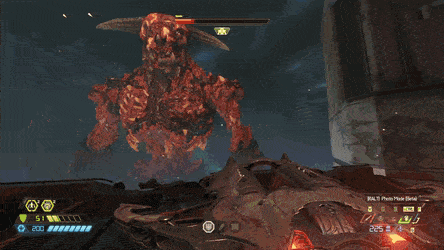
We can also make the boss do something to alleviate its human fragility, e.g. get into a mech suit/tank/giant death machine, mutate into a monster, or was never human to begin with - a demon, an alien, a monster, a robot, an angel, a dragon, a dinosaur, a god, whatever. With a reasonable in-universe explanation to why the last boss no longer has all of the normal human fragility, we don't feel the dissonance anymore and can happily fight a boss driving a scorpion tank with accompanying sonic cannon and acid drone swarm.
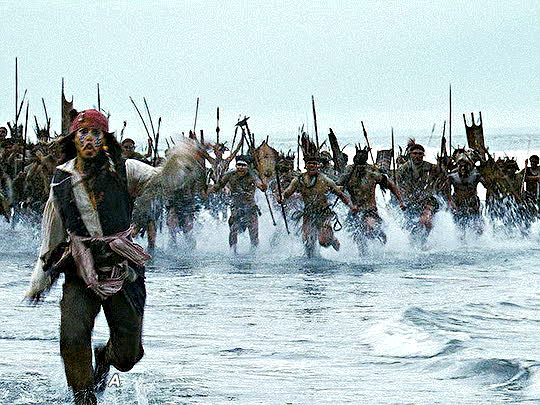
A third approach is to change the parameters of the encounter so it isn't just a fight. The final mission could be, for example, to infiltrate the final boss's lair, assassinate the final boss, and then successfully extract from that lair. The final mission could be obtaining/destroying the McGuffin that the player and the enemy have been chasing over the course of the game. It could just be "survive long enough" while something happens, like uploading evidence to expose the bad guy's wrongdoing to the world.

As you can see, there's a lot of possibilities to make engaging and different final boss encounters. Not everything has to fall into just standing and shooting each other until one side runs out of health. If we change the parameters of the conflict, we can make the encounter different and interesting. We can do this by adjusting other parameters within the fight, changing the boss's state to alleviate human fragility, or even change the goals so that the boss encounter is more than just a gunfight. As a design exercise, can you think of other methods of a final FPS boss fight that maintains the boss's humanity but still makes it reasonably engaging?
[Join us on Discord] and/or [Support us on Patreon]
Got a burning question you want answered?
Short questions: Ask a Game Dev on Twitter
Long questions: Ask a Game Dev on Tumblr
Frequent Questions: The FAQ
34 notes
·
View notes
Text
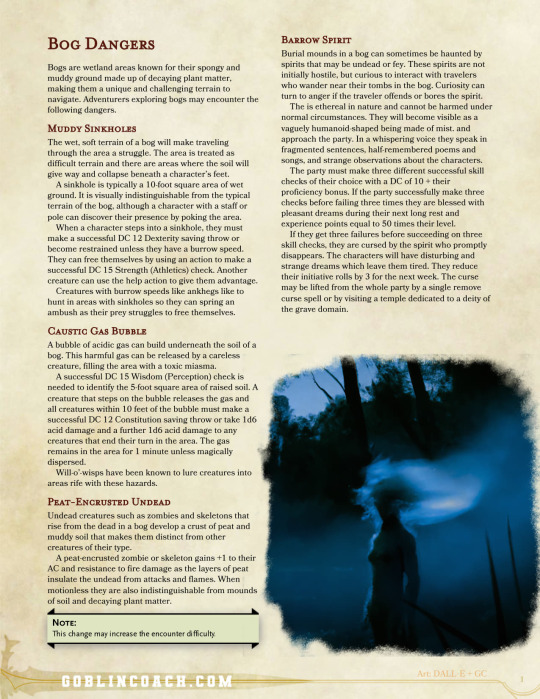
Bog Dangers by GoblinCoach on reddit
10 notes
·
View notes
Text
official dnd post
My friend sometimes brings her six-year-old to our DnD sessions and my husband (the DM) lets her roll for all enemy attacks and sometimes he will show her a few figures and let her secretly pick what creature we meet next. Who needs encounter tables when you have a first-grader around
97K notes
·
View notes
Text
Lessons from playing "Fallout 4"
So, I've been playing "Fallout 4" lately - certainly a time sink! FO4 keeps drawing me in even though I could take or leave its story or, let's say, its many design shortcomings. Still, FO4 is a big sandbox you can explore which is what I do most of the time when I play the game, and the level designers have more than a few tricks up their sleeve that might apply to tabletop RPGs as well.
The Journey is the Goal
So, you have a new quest. You get a marker on your map and your HUD to follow. You can even fast-travel to the nearest location. Easy-peasy, right?
What happens next is you finding your way towards your goal - navigating urban landscapes, trying to find a way to cross a river, going through places you might not have been before. As you do so, you inevitably stumble across more things - more of the game itself, interesting locations, little stories, and the leads to other quests, even.
This all has very little to do with the goal you set out for. Whether you fight the Mechanist's robotic minions (or watch them slug it out with various Wasteland denizens), run into the inevitable feral ghouls, or a raider gang, or come across a Supermutant fortress - none of this is actually related to your goal. But it's all part of playing the game. By playing the game, you come across more, well, game!

As you criss-cross the map, as you make your beeline to your actual goal, you will either follow a lot of side treks or ignore them, your choice.
Now, if your tabletop game is a sandbox, this is natural. As the players trek across your map, they come over the things you have seeded into your sandbox - which might have nothing to do with their goal of getting to a particular dungeon. But you can expose them to it and they can chose to interact with it, file it away for later, etc. It surely beats your two or three random encounters the GM rolled on a table.
But, let's say your game wasn't built like this. It still should have several theme threads you can weave to generate situations. If your setting is some world getting overrun by monsters from another dimension, let your encounters match that. Instead of just running into such monsters, generate situations where players might see such monsters attacking the people of the land - like a hamlet or small farmstead. While their choice might be obvious, it's still their choice to engage. Another monster encounter on the road might be entirely avoidable. But it might also be monsters clustering over something that might promise some reward - like the corpse of a high level knight. Or, taking a page from the ooold game "Pool of Radiance", you meet some weaker, local, intelligent monsters (kobolds, goblins, etc) who want to shake down the PCs for passage. The players can engage them, but it also costs resources, one way or another.
(Because if your game happens to be D&D, resources matter. But let's discuss that later.)
What I'm saying is that the payoff for setpiece encounters that you place in the players' way can be huge - in terms of making an immersive world. Encounters can obviously also be not hostile. It just so happens there's more going on in the world than the players' lives - or even the grand theme of the campaign. This can go from a broken wagon wheel of a wandering trader to a priest taking the local orphans for a hike near the forest border to whatever your mind can imagine in this world. Even if your world is grim-dark as fuck, there might be something you can think of - two farmers arguing over the damn boundary of their plots - that might even end up involving the players (if only to break up their fisticuffs). There's no end to rational or irrational behavior when it comes to people, after all.

Also, varying them is key, including the strategies required for dealing with them.
Resources, resources, resources
Now, this may not be a big issue in FO4 where the player is a pack mule full of gear eventually, but even there you don't have unlimited ammo, healing, and carrying capacity. You might eventually have the luxury of lugging around a lot of stuff, but you better bring stuff that helps you in your playing style. And leave space to lug things back.
As I said, in D&D resources matter. Now, most stuff that is not outright consumables (torches, healing potions, scrolls, etc) is not a concern in D&D, but you also have your daily allotment of spells and class powers. One of the reasons the discussion about the "15 minute adventuring day" never ends.
There are other constraints you can put on the players. Time limits, for example. (Use sparingly - else exploration and immersion go out of the window quickly. Must. Make. The. Deadline..!) Or the dungeon they're delving offers them no good resting options (except for maybe short rests - you should generally make room for a few of these to not break some classes), so a base camp is needed and trekking to their actual destination several times.
Remember those goblins asking for bribes? They might turn out to be a constant nuisance on the way to the actual dungeon unless the players manage to deal with them one way or another. They're no real threat, but they eat up - resources! (Or, nastier, they might be trading information with some dungeon denizens that might prepare an ambush.)

Or you can think of the approach to the dungeon as their own "dungeon rooms" of rather big proportion that the players have to go through and solve what's in them just the same. Just calculate it into their adventuring day/what the party can handle. And if you put obstacles on the way back, factor in what shape the party might be in at that point at your own discretion. Maybe the goblins see their pay-day when the players are exhausted and the wizard out of spells?
But back to FO4
Another thing you will do in FO4 a lot is looking for the actual location "on location." Where is that entrance to the sewers? Do you have to go through a full building to get to the actual location? Do you have to track back and forth over a location to get where you want to?
In a sense this is map design for RPGs as well. Blocked passages, for example, requiring backtracking. And the first layer of your dungeon might be an unrelated location to explore. The ruined house atop the mad wizard's laboratory might be a lower level challenge for your new party to gather experience before entering their goal proper.
There are a few differences, though. In FO4, "empty space" still needs to be traversed. Empty streets, locations you have cleared. These can still add suspense - as you might still run into some monsters. Or the game choses to place some of the scripted encounters there. Space can add a bit of quiet before the suspense.

Empty rooms, though... String enough of them in a dungeon and you get a lot of boredom. I mentioned this before, but "Swords & Wizardry" had modules released by its authors initially, but the dungeons - were plain uninteresting. Not much story weaving the rooms together, and way too many empty rooms. Nothing to discover, nothing to do. And by discover, I mean also no hidden things. This was quite the opposite to "Dungeon Crawl Classics" (very focused maps full of stuff) and "Lamentations of the Flame Princess" (some maps entirely woven with the story, others designed to screw players). So you can imagine why these games have gained popularity, while S&W is mostly useful for groups playing old material, for example, or to release material written for older editions with a rules set people have easy (and legal) access to.
Still, empty space is useful. It provides space for battles to spill over into. It's buffer between encounter zones that can help not every battle draw in every other monster in the vicinity. And empty space is - not empty!
"Empty rooms" should have served a purpose and hence contain furniture, left-over items, or have been used as the ever-elusive dungeon toilet. I'm not talking about rooms tied into an encounter area - like a monster's meat locker, making us aware that there's danger around. But even empty rooms should encourage exploration, and are chances to give minor loot, space to rest, and divulge the lore of a place. Some players might even try to break through to other places of the map from a seemingly unimportant location. (After all, in a tabletop the map need not be static. Just ensure that too much "tunneling" comes at a cost - noise, destabilizing the structure, etc.)
Clues and Lore
And I did mention lore in that list. FO4 locations do have details not pertaining to what you are trying to achieve - like graffiti from long ago, or files from the time before the bombs fell, etc. This is especially effective if paying attention to it helps the players do what they want to do.

Some players make their own clues, so beware. Has dust been disturbed - that's popular. Or wet footsteps if it rained outside. Players can be surprisingly resourceful, and sometimes that should be rewarded. Even if you have to do it on the spot.
Mix clues with noise with lore. Noise can be inspired by lore but is generally useless. Every environmentally hinted piece of lore is a piece of exposition the players discovered. The background of a painting, for example.
You can even devise whole stories that played out in the location, like a previous delving attempt that the players didn't know of, leading to a whole breadcrumb trail to follow. A great example happens in "Pool of Radiance" - another party went into the haunted graveyard and slew the vampire (which hence does not appear in the game, natch), but were too weakened after that to make it back out through the accursed location. So, one of the boss fights never happened, but the story added quite a bit to the mood of the place. (And is told as a one last diary entry - I'm sure the idea might have been lifted from Tolkien. Drums in the deep...)

These stories can inspire the presence of monsters as well: In one location in FO4 the monsters you fight are a raider gang trying to loot the location you're about to search - and you run into them as they are pinned down by a machine gun turret. By other agents in the world doing things you can credibly add surprising things to locations. You can even add allies to set up a bigger battle down the line.
At the same time, you can run into adversaries that, when bested, "drop" more clues and lore. Or you can listen in on them. Be prepared for rewarding sneaky characters!
Not very random
One final thought: FO4 may have a good deal of "more of the same." After all, if you want to have well-designed, good-looking adversaries, you have to limit how many types you make. So FO4 tries to use them a lot, and uses them in many different ways.
What it does not, however, is use them at random. Certain adversaries prefer certain locations and are planned into them - like ghouls rising after being mistaken for nearby corpses, mole rats and radscorpions bursting out of the ground, etc. Level designers placed a lot of your adversaries, and while they might eventually respawn, they are not there at random. Which makes it fun if some of the actual random or mobile elements crash into them - like your supply caravans or a wandering trader with guards running into someone raiders.
But in general, not a lot is random here. Many locations have their enemies placed and dispersed, and when triggered, they act according to their own logic. Some have their behaviors scripted initially before the fighting breaks out.
In this article I tried to highlight the value of all the design and scripting that went into FO4 and how similar approaches could enliven your game as well. In a sense, it's better to draw inspiration from a random encounter table than it is to use one, at times. It can tell you what can happen as a result of player actions. A tabletop RPG can be a very dynamic, smart environment, if you let it be.
It's up to you to find the mix of elements that makes it dynamic, responsive, and alive without becoming overwhelming. Good luck!
#fallout 4#tabletop roleplaying#pen & paper#roleplaying#dungeon design#encounter design#random encounter
0 notes
Text

Who doesn't like helpfull zombies?
Faaargh! Doooorgh! ... Reeee! Doooorgh! Heeeer!
#dnd#dungeons and dragons#dnd5e#5e#fantasy#homebrew#fiction#side quests#ttrpg#tabletop#level design#encounter design#random encounters
1 note
·
View note
Text
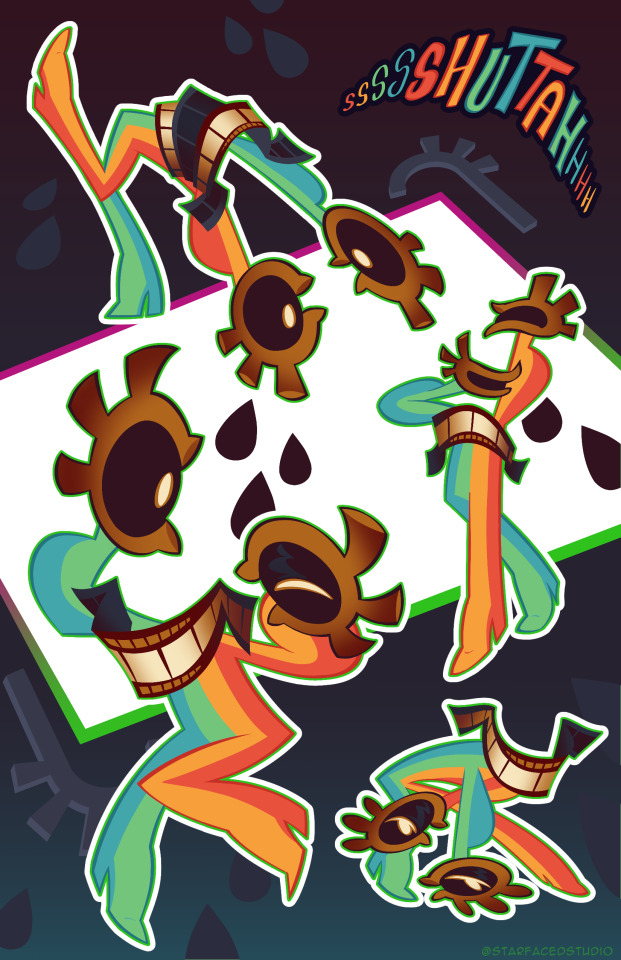
Our resident camerathing!
#deltarune#froxart#described#shuttah#deltarune spoilers#not gonna pretend i know exactly what object it represents . i assume a family camera or tube of film but idk if it was ever confirmed...?#but i DO wanna say shuttah is one of my fav encounter designs in ch3 especially paired with the mechanic it has :)#shout out to shuttah. ur cool.#and shout out to having it/its swag. go my thing
872 notes
·
View notes
Text
Encounter concept: your party goes into the local Goblin cave and, due to the volume of adventurers that the village has been sending after them, they have hired a Cavern Secretary to manage appointments for raids and counter-raids.
Your party has to find a way to negotiate an appointment with the Cavern Secretary that'll allow them to attack the Goblins before they do their big siege in the next few days, otherwise the village will be lost.
11K notes
·
View notes
Text
Steal this encounter -
Before you stands a crumbling courtyard, uneven paths of mossy cobbles weaving between choked and overgrown flowerbeds. In the far corner, what remains of a statue sits covered in climbing ivy. In the nearer, an old, weathered well which might once have been covered by a small roof, now rotted away. The rope coil from its decaying timbers terminates in a frayed end, but a crude wooden bucket has been left nearby. A lone tree sits near the center of the garden, its roots thick and twisting. One particularly gnarled root has pushed up a thick chunk of soil, beneath which there is a faint glint of something metal.
Casual examination of the lifted soil reveals a half-buried wooden chest, fitted with brass.
A more careful examination and the right skills is needed to notice signs that the chest was placed after the soil was lifted by the root, not before.
The chest is unlocked, and contains only minor loot, but is also fitted with a fire trap, which will douse those nearby in flaming oil if it is still armed when the chest is opened. Breaking the chest open will also set off the trap.
The bucket by the well is actually a mimic.
The true value of the garden is in the medicinal herbs it contains, which can be harvested by a character with the proper knowledge to make potions at a reduced cost.
#tabletop roleplaying#fantasy roleplay#dungeons & dragons#pathfinder#encounter design#game mastering#dungeon mastering#steal this
4 notes
·
View notes
Text
My biggest problem with dnd 5e is probaly attack of oppurtunity
It makes designing encounters without teleporting enemies a nightmare (and I prefer to keep teleportation semi limited in monsters) as it just makes movement unvaible for players and monsters once they are close to each other and the thing is just removing it just isnt possible imo and I dont even know where to begin if I would try changing it. And I know some people will go well just give your pc's an objective in combat but a lot of times that simply isnt possible/ in the scope of the encounter/ makes sense. Beyond that there are even more problems with it. I do understand that a lot of this probaly just comes down from how I design encounters but I just felt like I needed to vent about this.
0 notes